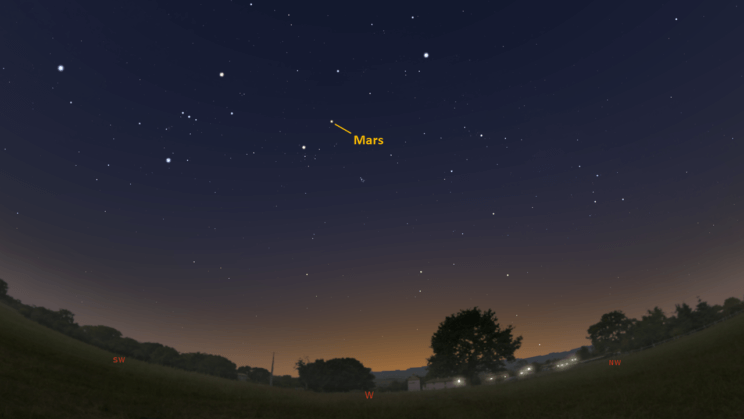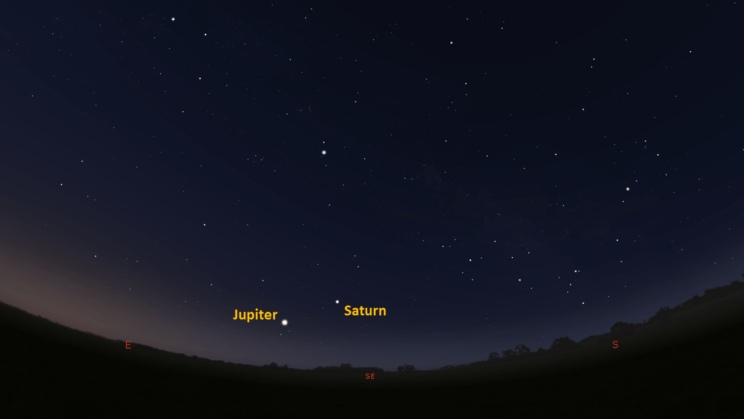This is the Saint Louis Science Center’s NIGHT SKY UPDATE for the week of Friday, March 26, 2021.
Information updated weekly or as needed.
Times given as local St. Louis time which is Central Daylight Time (CDT). For definitions of terminology used in the night sky update, click the highlighted text. If relying on times posted in Universal Time (UT), St. louis is -5 hours when CDT.
Public Telescope Viewings
Star parties at the Saint Louis Science Center have temporarily been canceled due to recommendations from the CDC regarding COVID-19. All public telescope events are canceled until further notice. As conditions change, we will reevaluate and update this article once public observing events resume.
Observing Highlight of the Week
As spring is now upon us, the world is changing with the season. Warmer temperatures are beckoning us to go out and enjoy what nature has to offer. With the changing seasons we are greeted with familiar sights and sounds such as fireflies and the drone of cicadas. This changing diversity of plants and animals can be a fascinating addition to our observation of the sky. As temperatures begin to rise and our soil temperatures increase, we can expect the return of those noisy bugs called cicadas. These fascinating creatures spend most of their lives underground until they reach adulthood and emerge to find a friend. The noise you hear is from the males trying to attract the attention of a female counterpart.
Cicadas come in two varieties which are annual and periodical. The periodical cicadas are the ones that emerge in 13- or 17-year cycles. Cicadas are found around the world, but periodic cicadas are only found in eastern portions of North America. Periodic cicadas are organized into broods which are based on when and where they emerge. In Missouri, four broods are found: two 13-year and two 17-year.
This year you might hear a lot about cicadas as 2021 will see the return of the 17-year Brood X (10). Unfortunately, St. Louis is on the sideline for this mass emergence as their region extends from New York to Georgia and only as far west as Illinois. For those with family and friends in this region, they are about to experience a mass emergence. Even though we may not be part of the region, this year offers us a good chance to learn about these creatures as we are due for our next 17-year brood in 2024. This is known as Brood XIX (19) which should impact most of Missouri that year.
As we wait for our next mass emergence of cicadas in 2024, it is a good time to take a moment to enjoy the amazing diversity of life around us. Declining populations of things like fireflies (lightning bugs), are a good reminder that the world is changing. Things many of us may have fond memories of may not always be around. For those interested in learning more about cicadas and their fascinating life cycles, visit https://mdc.mo.gov/trees-plants/diseases-pests/periodical-cicadas
The Sun and Moon

The Moon as seen from the International Space Station, on July 31, 2011.
Credit: NASA
Sunrise is at 6:55 a.m. on Friday, March 26 and sunset is at 7:19 p.m. providing us with nearly 12.5 hours of daylight. Even after sunset, the light from the Sun will dimly illuminate our sky for about 1 hour and 30 minutes. This period is called twilight, which ends around 8:49 p.m. this week. For those with a sundial, local noon occurs around 13:07 p.m. this week.
| Day | Sunrise | Sunset |
|---|---|---|
| 2021-03-26 | 6:55 a.m. | 7:19 p.m. |
| 2021-03-27 | 6:53 a.m. | 7:20 p.m. |
| 2021-03-28 | 6:52 a.m. | 7:21 p.m. |
| 2021-03-29 | 6:50 a.m. | 7:22 p.m. |
| 2021-03-30 | 6:49 a.m. | 7:23 p.m. |
| 2021-03-31 | 6:47 a.m. | 7:24 p.m. |
| 2021-04-01 | 6:45 a.m. | 7:25 p.m. |
| 2021-04-02 | 6:44 a.m. | 7:26 p.m. |
| 2021-04-03 | 6:42 a.m. | 7:27 p.m. |
Moon
Moonrise for Friday, March 26 occurs at 5:02 p.m. and moonset will occur at 6:37 a.m. on the following day. On Friday, March 26 the Moon will exhibit a waxing gibbous phase with 95% of the lunar disk visible. Full moon for March occurs on March 28 at 1:48 p.m. March’s full moon is often called the Full Worm Moon.
International Space Station (ISS) Observing

Visible passes of ISS from St. Louis for the week of March 26 occur during morning and evening hours. The best passes this week occur on the evenings of April 1 and 2. Use the table below for information about these and other visible passes this week.
Catch ISS from St. Louis starting Friday, March 26
| Date | Starts | Max. altitude | Ends | |||||||
|---|---|---|---|---|---|---|---|---|---|---|
| Time | Alt. | Az. | Time | Alt. | Az. | Time | Alt. | Az. | ||
| 28 Mar | -1.1 | 21:26:49 | 10 | NNW | 21:28:05 | 14 | N | 21:28:05 | 14 | N |
| 30 Mar | -1.6 | 21:28:17 | 10 | NNW | 21:30:04 | 23 | N | 21:30:04 | 23 | N |
| 31 Mar | -2 | 20:41:06 | 10 | NNW | 20:43:44 | 21 | NNE | 20:44:36 | 19 | NE |
| 01 Apr | -1.5 | 19:53:58 | 10 | NNW | 19:56:07 | 16 | NNE | 19:58:17 | 10 | ENE |
| 01 Apr | -2.3 | 21:30:01 | 10 | NW | 21:32:10 | 36 | NW | 21:32:10 | 36 | NW |
| 02 Apr | -3.2 | 20:42:40 | 10 | NW | 20:45:56 | 46 | NE | 20:46:48 | 36 | ENE |
| 03 Apr | -2.5 | 19:55:25 | 10 | NNW | 19:58:26 | 29 | NNE | 20:01:27 | 10 | E |
| 03 Apr | -1.9 | 21:32:14 | 10 | WNW | 21:34:29 | 27 | WSW | 21:34:29 | 27 | WSW |
Magnitude (Mag): The Measure of brightness for a celestial object. The lower the value is, the brighter the object will be.
Altitude (Alt): The angle of a celestial object measured upwards from the observer’s horizon.
Azimuth (Az): The direction of a celestial object, measured clockwise from an observer’s location with north being 0°, east being 90°, south being 180° and west being 270°.
For information about ISS flyovers and other visible satellites, visit www.heavens-above.com
Detailed information regarding all unmanned exploration of our universe, missions past, present, and planned, can be found at Jet Propulsion Laboratories:
The Visible Planets

Looking West, at 8:00 pm, March 26, 2021
Credit: Stellarium, EG,

Looking East Southeast, at 6:00 am, March 27, 2021
Credit: Stellarium, EG
This week, three naked eye planets are visible. Mars is found high in the west after sunset. Jupiter and Saturn can be found in the east southeast before sunrise.
Mars
Currently Mars appears as a 1.2-magnitude object that will be visible high in the west about 40 minutes after sunset. Mars sets by 12:52 a.m.
Jupiter
Jupiter is starting to climb out of the Sun’s glare just before sunrise. For your best chance to see Jupiter, look east southeast 1-hour before sunrise.
Saturn
Saturn has returned to our morning sky. Look east southeast 1-hour before sunrise to find the ringed planet.
Mars Perseverance Rover Update
After a successful landing on Mars, NASA’s newest rover Perseverance is beginning the early stages of its mission. Each week this section will contain a few of the images sent back to Earth as Perseverance explores Jezero crater. If you have not seen it yet, the first thing I would recommend watching is a video NASA released of the rover’s landing.
NASA’s Mars Exploration Program website will be a good resource to visit each day to find any updates on the rover and its mission. Aside from information about Perseverance, NASA’s website will keep you up to date on any new findings from other Mars missions and research.

Perseverance Drops Debris Shield that Covered Ingenuity
Credit: NASA/JPL-Caltech/MSSS
James S. McDonnell Planetarium
Night Sky Update: March 26-April 03, 2021






